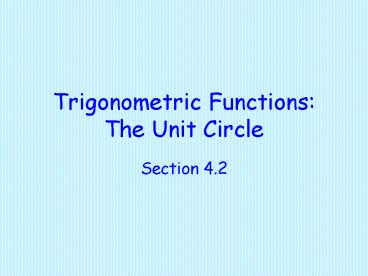Trigonometric Functions: The Unit Circle - PowerPoint PPT Presentation
Title:
Trigonometric Functions: The Unit Circle
Description:
Determine the tangent, cotangent, secant, and cosecant values of an angle given ... secant of an angle. cosecant of an angle. Unit Circle ... – PowerPoint PPT presentation
Number of Views:207
Avg rating:3.0/5.0
Title: Trigonometric Functions: The Unit Circle
1
Trigonometric Functions The Unit Circle
- Section 4.2
2
Objectives
- Find a point on the unit circle given one
coordinate and the quadrant in which the point
lies. - Determine the coordinates of a point on the unit
circle given a point on the unit circle. - State the sign of the sine or cosine value of an
angle based on the quadrant in which the terminal
side of an angle occurs. - State the sine and cosine values of an angle
(measured in radians) where the angles have a - measure of
3
Objectives
- Determine the tangent, cotangent, secant, and
cosecant values of an angle given a point on the
unit circle. - State the sign of the tangent, cotangent, secant,
and cosecant value of an angle based on the
quadrant in which the terminal side of an angle
occurs. - Determine the tangent, cotangent, secant, and
cosecant values of an angle (measured in radians)
where the angles have a measure of
4
Vocabulary
- quadrant
- sine of an angle
- cosine of an angle
- terminal side of an angle
- initial side of an angle
- tangent of an angle
- cotangent of an angle
- secant of an angle
- cosecant of an angle
5
Unit Circle
6
If the point is on the unit circle in
quadrant IV, then find y.
7
If P(t) has coordinates (0.141, 0.99), find the
coordinates of each point indicated below.
8
Find the terminal point P(x, y) on the unit
circle determined by the value of
9
If , find the sin(t) and cos(t).
10
If , find the sin(t) and cos(t).
11
If , find the sin(t) and cos(t).
12
Quotient Identities
13
Reciprocal Identites
14
Pythagorean Identity

